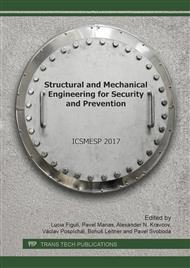[1]
R. Melcher, Structural Reliability Analysis and Prediction, 2nd ed, Wiley & Sons, (1999).
Google Scholar
[2]
M. Handrik, M. Vasko, P. Kopas, M. Sága, Effective finite element solution and post-processing for wide load spectrum, Komunikácie - Communications, Vol. 16, Iss. 3A (2014), pp.19-26.
DOI: 10.26552/com.c.2014.3a.19-26
Google Scholar
[3]
P. Kopas, M. Sága, M. Vaško, Contribution to multiaxial damage calculation using FEM, Applied Mechanics and Materials. Vol. 420 (2013), pp.318-324.
DOI: 10.4028/www.scientific.net/amm.420.318
Google Scholar
[4]
M. Vaško, M. Sága, Application of fuzzy structural analysis for damage prediction considering uncertain S/N curve. Applied Mechanics and Materials, Vol. 420 (2013), pp.21-29.
DOI: 10.4028/www.scientific.net/amm.420.21
Google Scholar
[5]
Ch. Lalanne, Fatigue Damage, CRC Press, 2002, 307 p.
Google Scholar
[6]
M. Mohammadi, M. etal, An evaluation of total fatigue life prediction of a notched shaft subjected to cyclic bending load, Engineering Fracture Mechanics, Vol. 166 (2016), pp.128-138.
DOI: 10.1016/j.engfracmech.2016.08.027
Google Scholar
[7]
A. Varvani-Farahani, C.A. Brebbia, Fatigue Damage of Materials: Experiment and Analysis, WIT Transactions on Engineering Sciences, volume 40 (2003), pp.528-537.
Google Scholar
[8]
J. Lemaitre, R. Desmorat, Engineering Damage Mechanics: Ductile, Creep, Fatigue and Brittle Failures, Springer Science & Business Media, 2005, 380 p.
DOI: 10.1002/zamm.200590044
Google Scholar
[9]
W.F. Pan, Ch.Y. Hung, L.L. Chen, Fatigue life estimation under multiaxial loadings, Int. journal of Fatigue, Vol. 21, Iss. 1 (1999), pp.3-10.
DOI: 10.1016/s0142-1123(98)00050-4
Google Scholar
[10]
J. Papuga, S. Parma, M. Růžička, Systematic validation of experimental data usable for verifying the multiaxial fatigue prediction methods, Frattura ed Integrita Strutturale, Vol. 10, Iss. 38 (2016), pp.106-113.
DOI: 10.3221/igf-esis.38.14
Google Scholar
[11]
Leitner, B, Safety enhancement and fatigue life prediction of the lorry frames carrying elements by using of real working conditions simulation, Diagnostyka, Nr. 2/54 (2010), pp.11-16.
Google Scholar
[12]
Information on http: /www. pragtic. com.
Google Scholar
[13]
F. Ellyin, Fatigue Damage, Crack Growth and Life Prediction, Springer 2011, 470 p.
Google Scholar
[14]
M. Wang, Q. Fei, P. Zhang, A Modified Fatigue Damage Model for High-Cycle Fatigue Life Prediction, Advances in Materials Science and Engineering, Vol. 2016 (2016), ID 2193684, 7 p.
DOI: 10.1155/2016/2193684
Google Scholar
[15]
M. Handrik, M. Vaško, P. Kopas, V. Mózer, The linear and nonlinear stability loss of structures due to thermal load, Procedia Engineering, Vol. 136 (2016), pp.359-364.
DOI: 10.1016/j.proeng.2016.01.223
Google Scholar
[16]
W. Wu, T. Fu, C. Yang, Study of Fatigue Damage Accumulation and Fatigue Reliability Based on Rotating Bending Test Data, SAE Technical Paper 2006-01-1334, (2006).
DOI: 10.4271/2006-01-1334
Google Scholar
[17]
L. Figuli, Š. Jangl, D. Papán, Modelling and Testing of Blast Effect On the Structures, World Multidisciplinary Earth Sciences symposium (WMESS), Prague, September 05-09, 2016, Series: IOP Conference Series-Earth and Environmental Science, Vol. 44, Article Number: 052051.
DOI: 10.1088/1755-1315/44/5/052051
Google Scholar
[18]
T. Lack, J. Gerlici, A modified strip method to speed up the tangential stress between wheel and rail calculation, Applied Mechanics and Materials, Vol. 486 (2014), pp.371-378.
DOI: 10.4028/www.scientific.net/amm.486.371
Google Scholar
[19]
Information on http: /www. croberts. com/minneapolis-bridge-collapse. htm.
Google Scholar


